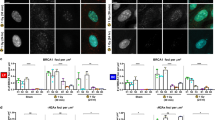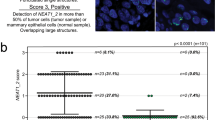Abstract
We have characterized expression of the familial breast and ovarian cancer gene, BRCA1, in cases of non–hereditary (sporadic) breast cancer and analyzed the effect of antisense inhibition of BRCA1 on the proliferative rate of mammary epithelial cells. BRCA1 mRNA levels are markedly decreased during the transition from carcinoma in situ to invasive cancer. Experimental inhibition of BRCA1 expression with antisense oligonucleotides produced accelerated growth of normal and malignant mammary cells, but had no effect on non–mammary epithelial cells. These studies suggest that BRCA1 may normally serve as a negative regulator of mammary epithelial cell growth whose function is compromised in breast cancer either by direct mutation or alterations in gene expression.
This is a preview of subscription content, access via your institution
Access options
Subscribe to this journal
Receive 12 print issues and online access
$209.00 per year
only $17.42 per issue
Buy this article
- Purchase on Springer Link
- Instant access to full article PDF
Prices may be subject to local taxes which are calculated during checkout
Similar content being viewed by others
References
Hall, J.M. et al. Linkage of early-onset breast cancer to chromosome 17q21. Science 250, 1684–1689 (1990).
Miki, Y. et al. A strong candidate gene for the breast and ovarian cancer susceptibility gene BRCA1. Science 266, 66–71 (1994).
Friedman, L.S. et al.Confirmation of BRCA by analysis of germline mutations linked to breast and ovarian cancer in ten families. Nature Genet. 8, 399–404 (1994).
Castilla, L.C. et al. Mutations in the BRCA1 gene in families with early-onset breast and ovarian cancer. Nature Genet. 8, 387–391 (1994).
Simard, J. et al. Common origins of BRCA1 mutations in Canadian breast and ovarian cancer families. Nature Genet. 8, 392–398 (1994).
Narod, S.A. et al. A heterogeneity analysis of 145 breast-ovarian cancer families. Am. J. hum. Genet. 56, 254–264 (1995).
Merajver, S. et al. Somatic mutations in the BRCA1 gene in sporadic ovarian tumours. Nature Genet. 9, 439–443 (1995).
Holt, J.T., Jensen, R.A. & Page, D.L., Old principles and new methods. in Cancer Surveys Advances and Prospects in Clinical, Epidemiological and Laboratory Oncology (eds Fentiman, I. & Taylor-Papadimitriou, J.) 18, 115–133 (Cold Spring Harbor Laboratory Press, Cold Spring Harbor, 1993).
Jensen, R.A., Page, D.L. & Holt. J.T. Identification of genes expressed in premalignant breast disease by microscopy-directed cloning. Proc. natn.Acad. Sci. U.S.A. 91, 9257–9261 (1994).
Betsill, W.L., Rosen, P.P., Liberman, P.M. & Robbins, G.F. Intraductal carcinoma: long-term follow-up after treatment by biopsy alone. J. Am. med. Assoc. 239, 1863–1867 (1978).
Page, D.L., Dupont, W.D., Rogers, L.W. & Landenberger, M. Intraductal carcinoma of the breast: follow-up after biopsy. Cancer 49, 751–758 (1982).
Page, D.L. & Dupont, W.D. Atypical hyperplastic lesions of the female breast. A long term follow-up study. Cancer 66, 1326–1335 (1990).
Stampfer, M., Hallowes, R.C. & Hackett, A.J. Growth of normal human mammary cells in culture. In Vitro 16, 415–425 (1980).
Soule, H.D. & McGrath, C.M. Estrogen responsive proliferation of clonal human breast carcinoma cells in athymic mice. Cancer Letters 10, 177–189 (1980).
Robinson-Benion, C. & Holt, J.T. Antisense strategies for oncogene research in Methods in Enzymology (eds Vogt, P. & Verma, I.) (Academic Press, San Diego, in the press).
Marcus, J.N., Watson, P., Page, D.L. & Lynch, H.T. Pathology and heredity of breast cancer in younger women. J. natn.Cancer. Inst. Monograph No. 16, 23–34 (1994).
Neuhausen, S.L. & Marshall, C.J. Loss of heterozygosity in familial tumours from three BBCAJ-linked kindreds. Cancer Res. 54, 6069–6072 (1994).
Jacobs, I.J. et al. A deletion unit on chromosome 17q in epithelial ovarian tumours distal to the familial breast/ovarian cancer locus. Cancer Res. 53, 1218–1221 (1993).
Saito, H. et al. 17q in ovarian and breast cancers: 2-cM region on 17q21.3 often and commonly deleted in tumours. Cancer Res. 53, 3382–3385 (1993).
Cropp, C.S. et al. Evidence for involvement of BRCA1 in sporadic breast carcinomas. Cancer Res. 54, 2548–2551 (1994).
Xue, D., Tu, Y. & Chalfle, M. Cooperative interactions between the C. elegans homoproteins Unc-86 and Mec-3. Science 261, 1324–1328 (1993).
Reuter, R. et al. Homeotic genes regulate the spacial expression of putative growth factors in the visceral mesoderm of Drosophlla embryos. Development 110, 1031–1040 (1990).
Page, D.L. & Dupont, W.D. Anatomic indicators (histologic and cytologic) of increased breast cancer risk. Breast Cancer Res. Treat. 28, 157–166 (1993).
Holt, J.T., Redner, R.L. & Nienhuis, A.W. An oligomer complementary to c-myc mRNA inhibits proliferation of HL-60 promyelocytlc cells and induces differentiation. Molec. cell. Biol. 8, 963–973 (1988).
Author information
Authors and Affiliations
Rights and permissions
About this article
Cite this article
Thompson, M., Jensen, R., Obermiller, P. et al. Decreased expression of BRCA1 accelerates growth and is often present during sporadic breast cancer progression. Nat Genet 9, 444–450 (1995). https://doi.org/10.1038/ng0495-444
Received:
Accepted:
Issue Date:
DOI: https://doi.org/10.1038/ng0495-444
This article is cited by
-
Retarding breast tumor growth with nanoparticle-facilitated intravenous delivery of BRCA1 and BRCA2 tumor suppressor genes
Scientific Reports (2023)
-
Progress and prospects in research and clinical practice of hormone receptor-positive, HER-2-negative breast cancer with BRCA1/2 mutations
Discover Oncology (2023)
-
High BRCA1 gene expression increases the risk of early distant metastasis in ER+ breast cancers
Scientific Reports (2022)
-
An Overview of PARP Inhibitors for the Treatment of Breast Cancer
Targeted Oncology (2021)
-
Sei-1 promotes double minute chromosomes formation through activation of the PI3K/Akt/BRCA1-Abraxas pathway and induces double-strand breaks in NIH-3T3 fibroblasts
Cell Death & Disease (2018)



